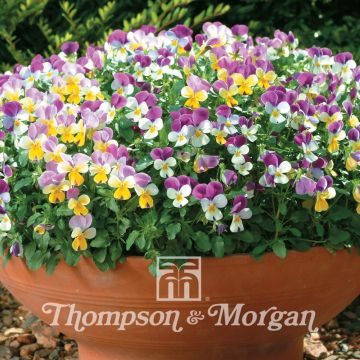

Graines de Viola Tete de Lapin (Bunny Ears) - Pensée hybride.
Viola x wittrockiana Bunny Ears - Pansy
Viola x wittrockiana Bunny Ears
Garden Pansy
Special offer!
Receive a €20 voucher for any order over €90 (excluding delivery costs, credit notes, and plastic-free options)!
1- Add your favorite plants to your cart.
2- Once you have reached €90, confirm your order (you can even choose the delivery date!).
3- As soon as your order is shipped, you will receive an email containing your voucher code, valid for 3 months (90 days).
Your voucher is unique and can only be used once, for any order with a minimum value of €20, excluding delivery costs.
Can be combined with other current offers, non-divisible and non-refundable.
Why not try an alternative variety in stock?
View all →This plant carries a 6 months recovery warranty
More information
We guarantee the quality of our plants for a full growing cycle, and will replace at our expense any plant that fails to recover under normal climatic and planting conditions.
Would this plant suit my garden?
Set up your Plantfit profile →
Description
The hybrid violet Viola x wittrockiana 'Bunny Ears' is simply splendid. Forming compact clumps, this small vigorous plant surprises with the abundance and shape of its extraordinarily colourful flowers, topped with two large elongated and upright petals resembling rabbit ears. Their "face", where bright pink, purple, white, golden yellow, and black compete and blend, makes one forget the rigours of February and accompanies spring blooms until May. More biennial than perennial, it will thrive in even the smallest pocket of fresh soil, flowering between the stones of a wall, in the gaps of a pavement, a damp rockery, and of course in flower pots.
Garden violets, sometimes called Swiss pansies, are hybrids grouped under Viola x wittrockiana. They belong to the violet family and are most often grown as annuals or biennials, although they are theoretically perennial, but have a short lifespan.
The variety 'Bunny Ears', in English "Oreille de Lapin", is distinguished by its flowers curiously adorned with long petals, with the two upper ones being particularly elongated. It is a bushy plant that quickly forms compact clumps, with a rounded habit, measuring 15-20cm (6-8in) in all directions. It blooms from late winter to late spring, or from late spring to the end of summer. Only intense heat slightly slows down its abundant flowering, although they will continue to bloom if moved to shade. 'Bunny Ears' pansies offer small but fully open flowers, with rich and intense colours, and a velvety texture. The flowers are multicoloured, with the two upper petals being fuchsia pink and purple, while the two lower petals are almost white. Around a bright yellow heart, small black "whiskers" radiate, accentuating the vibrancy of the colour. The medium green leaves are elliptical and broadly serrated.
If you love them in the garden, it is in containers, on the windowsill, to have them right under your nose while staying warm, that pansies will be most appreciated. You can, for example, associate them with primroses, Wallflowers, Grape Hyacinths, Daisies, and even with grasses like Japanese Sedge for a graphic effect in a contemporary spirit. This 'Bunny Ears' variety also adds a lot of whimsy to dry stone walls, alpine rockeries, or borders of a pathway in consistently moist soil. Combine pansies with heucheras and tulips. The glaucous blue-green colour of fescues also complements them well.
The petals of pansies are edible, and their colours will add a touch of originality to your salads and pastries. To do this, think of growing them as you would your vegetables, in the most natural way possible.
Report an error about the product description
Flowering
Foliage
Plant habit
Botanical data
Viola
x wittrockiana
Bunny Ears
Violaceae
Garden Pansy
Cultivar or hybrid
Other Violet seeds
View all →Planting and care
Sow the 'Bunny Ears' pansy in a nursery from July to September and then transplant the young plants into pots. Plant your young plants in October before the first frost, spacing them 20cm (8in) apart, in open ground.
Second option: sow indoors at the end of winter and plant the seedlings in open ground at the end of spring.
Germination takes about 15 days at 16°C (60.8°F).
Use a compound mixture of 1/3 potting soil, 1/3 garden soil, and 1/3 river sand. It takes 15 days for the seedlings to appear. Watch out for attacks from snails and slugs, as they are fond of these young plants. Removing faded flowers will promote flowering renewal.
Horned violets and pansies prefer a light soil, rich in humus, moist but well-drained, as they fear excessive moisture in winter. In heavy soil, add some sand to improve drainage.
Plant pansies in a sunny position, but not in direct sunlight or under light shade.
Sowing period
Intended location
Planting & care advice
This item has not been reviewed yet - be the first to leave a review about it.
Similar products
Haven't found what you were looking for?
Hardiness is the lowest winter temperature a plant can endure without suffering serious damage or even dying. However, hardiness is affected by location (a sheltered area, such as a patio), protection (winter cover) and soil type (hardiness is improved by well-drained soil).

Photo Sharing Terms & Conditions
In order to encourage gardeners to interact and share their experiences, Promesse de fleurs offers various media enabling content to be uploaded onto its Site - in particular via the ‘Photo sharing’ module.
The User agrees to refrain from:
- Posting any content that is illegal, prejudicial, insulting, racist, inciteful to hatred, revisionist, contrary to public decency, that infringes on privacy or on the privacy rights of third parties, in particular the publicity rights of persons and goods, intellectual property rights, or the right to privacy.
- Submitting content on behalf of a third party;
- Impersonate the identity of a third party and/or publish any personal information about a third party;
In general, the User undertakes to refrain from any unethical behaviour.
All Content (in particular text, comments, files, images, photos, videos, creative works, etc.), which may be subject to property or intellectual property rights, image or other private rights, shall remain the property of the User, subject to the limited rights granted by the terms of the licence granted by Promesse de fleurs as stated below. Users are at liberty to publish or not to publish such Content on the Site, notably via the ‘Photo Sharing’ facility, and accept that this Content shall be made public and freely accessible, notably on the Internet.
Users further acknowledge, undertake to have ,and guarantee that they hold all necessary rights and permissions to publish such material on the Site, in particular with regard to the legislation in force pertaining to any privacy, property, intellectual property, image, or contractual rights, or rights of any other nature. By publishing such Content on the Site, Users acknowledge accepting full liability as publishers of the Content within the meaning of the law, and grant Promesse de fleurs, free of charge, an inclusive, worldwide licence for the said Content for the entire duration of its publication, including all reproduction, representation, up/downloading, displaying, performing, transmission, and storage rights.
Users also grant permission for their name to be linked to the Content and accept that this link may not always be made available.
By engaging in posting material, Users consent to their Content becoming automatically accessible on the Internet, in particular on other sites and/or blogs and/or web pages of the Promesse de fleurs site, including in particular social pages and the Promesse de fleurs catalogue.
Users may secure the removal of entrusted content free of charge by issuing a simple request via our contact form.
The flowering period indicated on our website applies to countries and regions located in USDA zone 8 (France, the United Kingdom, Ireland, the Netherlands, etc.)
It will vary according to where you live:
- In zones 9 to 10 (Italy, Spain, Greece, etc.), flowering will occur about 2 to 4 weeks earlier.
- In zones 6 to 7 (Germany, Poland, Slovenia, and lower mountainous regions), flowering will be delayed by 2 to 3 weeks.
- In zone 5 (Central Europe, Scandinavia), blooming will be delayed by 3 to 5 weeks.
In temperate climates, pruning of spring-flowering shrubs (forsythia, spireas, etc.) should be done just after flowering.
Pruning of summer-flowering shrubs (Indian Lilac, Perovskia, etc.) can be done in winter or spring.
In cold regions as well as with frost-sensitive plants, avoid pruning too early when severe frosts may still occur.
The planting period indicated on our website applies to countries and regions located in USDA zone 8 (France, United Kingdom, Ireland, Netherlands).
It will vary according to where you live:
- In Mediterranean zones (Marseille, Madrid, Milan, etc.), autumn and winter are the best planting periods.
- In continental zones (Strasbourg, Munich, Vienna, etc.), delay planting by 2 to 3 weeks in spring and bring it forward by 2 to 4 weeks in autumn.
- In mountainous regions (the Alps, Pyrenees, Carpathians, etc.), it is best to plant in late spring (May-June) or late summer (August-September).
The harvesting period indicated on our website applies to countries and regions in USDA zone 8 (France, England, Ireland, the Netherlands).
In colder areas (Scandinavia, Poland, Austria...) fruit and vegetable harvests are likely to be delayed by 3-4 weeks.
In warmer areas (Italy, Spain, Greece, etc.), harvesting will probably take place earlier, depending on weather conditions.
The sowing periods indicated on our website apply to countries and regions within USDA Zone 8 (France, UK, Ireland, Netherlands).
In colder areas (Scandinavia, Poland, Austria...), delay any outdoor sowing by 3-4 weeks, or sow under glass.
In warmer climes (Italy, Spain, Greece, etc.), bring outdoor sowing forward by a few weeks.





























































